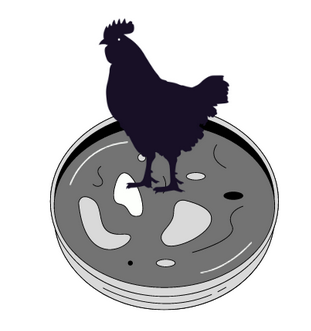The Chicken, the Egg, the Petri Dish
According to the USDA, poultry — specifically chicken — is the second most consumed meat in the world. But with all of this chicken consumption, what are the potential setbacks and how can we improve for the future?
This is where lab-grown meat comes into the mix. Realistically speaking, many of the foods we consume are either grown on a farm or have been subjected to some form of scientific intervention, such as GMOs. In this case, lab-grown chicken would be supplementing the farm-raised product with a meat not only better for the animals, but for us too!
It sounds promising, but how exactly does it work? It all starts with stem cells. In the question of what came first: the chicken or the egg, the petri dish wins.
This idea first came about when Jason Matheny, scientist and founder of New Harvest, questioned whether regenerative medicine techniques could be used toward the food industry. New Harvest is a non-profit organization that aims to support in-vitro meat research, specifically that of cultured meat products.
Lab-cultured meat isn’t a new idea; this was first popularized in the early 2000s when Matheny co-authored a paper talking about potential benefits. Even the most innovative of ideas can take a while to come around to, as denoted by the fact that this is still in the early stages of implementation. Introduction into normal society may take a long time, as FDA approval was first introduced in 2022.
Some of the benefits of cultured meat include less overcrowding on farms and transmission of animal-borne viruses, protection of animal rights and a significant reduction in greenhouse gas emissions (96%) and water consumption (82-96%), according to Oxford. However, not everyone is on board, specifically vegetarians and animal activists who believe this is an ethical violation because of the use of stem cells.
Not only does this impact the scientific community, but the farmers and workers who take care of these animals and provide our population with this livestock resource. How accessible will this sustainable option be, or is this yet another example of something that only benefits those that can afford it, rather than the marginalized communities that need it most?
Given the pros and cons, and the advancement of regenerative medicine, it seems as though lab-grown meat may be making its way onto our plates sometime soon. Even if it doesn’t necessarily walk or talk like a chicken, as long as it tastes like it (and there are no other glaring red flags, of course), why not?
If this is yet another scientific discovery that can help the trajectory of our planet by creating a larger availability of food and reducing the harm that we’ve already started, this is something that should have been implemented a long time ago.
What’s your verdict: would you eat lab-grown meat? Do you think you’d be able to tell? Do the pros outweigh the cons? Let us know in the comment section of the OP online: www.oaklandpostonline.com









Michele Jankowski • Feb 21, 2023 at 1:55 PM
Pastured organic chicken and pastured organic grass fed and finished beef are the only forms of meat we should be consuming. Check out Cooks Venture products. I would steer clear of any soy or corn based fake meats created in a factory, or stem cell lab-created products
Isabella Limbert • Feb 15, 2023 at 6:15 PM
Personally, I would eat lab-grown chicken, but that may or may not have to do with the fact that chicken is part of all of my favorite dishes… 🙂